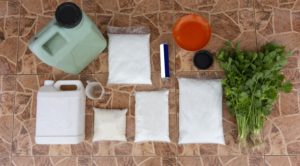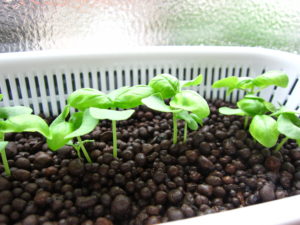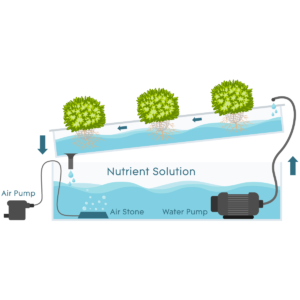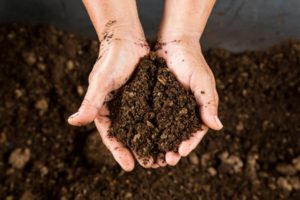There are a lot of questions that come up in hydroponics, a good portion of which are all about feeding the plant nutrients properly. Then, you have terms that come up like N-P-K ratio, micronutrients, electroconductivity, vegetative. There’s a lot to learn if you’re not familiar with hydroponic nutrients, so let’s take a look at how it all works, and what it all means.
Nutrient solution is essentially fertilizer. It’s what you give to your plants to provide the nutrients they need to grow. The primary nutrients in this solution are nitrogen (N), phosphorus (P), and Potassium (K). Each of these elements can be referred to as their symbol on the periodic table, and that’s true for any other element you add to nutrient solution.
With that in mind, you can see that NPK is just the main parts making up the fertilizer. Plants have different nutrient needs from each other. Added to that, plants require different amounts throughout different parts of their lives. That’s why these nutrients are mixed in different amounts to suit.
An NPK ratio is the proportions of each of the elements added to make this fertilizer ideal for a certain plant. When you look at a pre-mixed package of nutrient solution, you’ll also notice numbers along the N-P-K labeling. These numbers indicate the percentage of the solution that’s made up of each element.
So, if you see some nutrient solution labeled, “N-P-K 5-7-9” you know that nitrogen (N) comprises 5% of the mixture. Phosphorus (P) makes up 7%, and potassium (K) is 9% of the mixture.
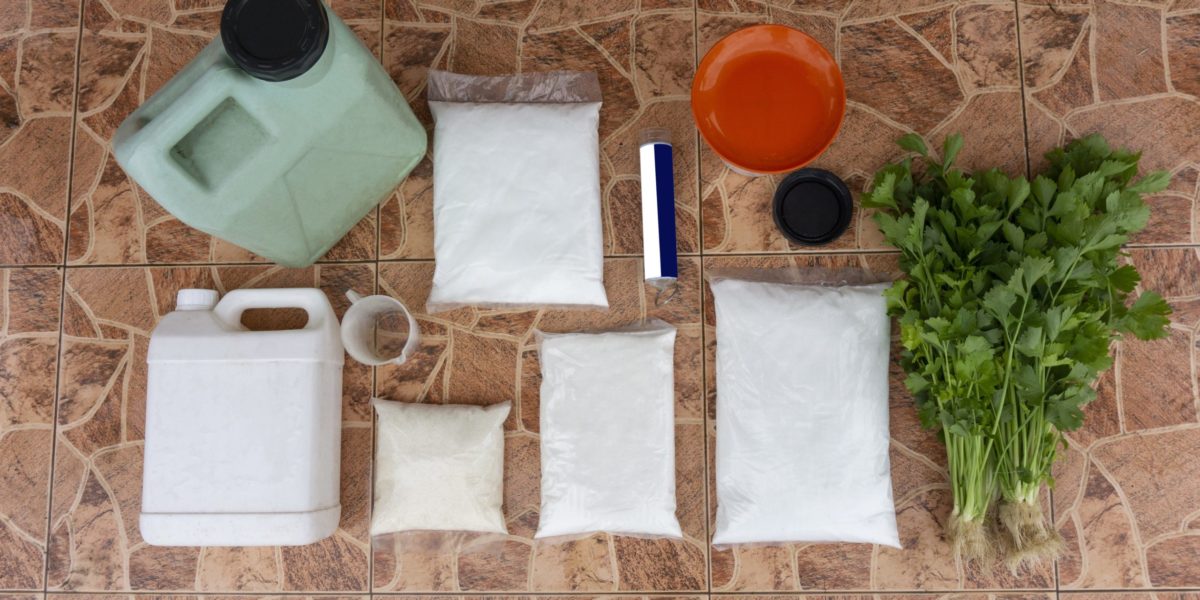
Important Hydroponic Nutrients
Nitrogen is widely considered one of the most important parts of nutrient solution. It allows plants to grow more foliage, and reinforce cell structures. Nitrogen helps plants produce chlorophyll. That’s why plants with a nitrogen deficiency often appear more yellow than green. In short, it’s a completely necessary hydroponic nutrient.
Phosphorus is important to plant growth, and plants use more of it when they’re germinating and growing into sprouts as well as flowering. A phosphorus deficiency may not be apparent in younger plants. They may simply look smaller, but they often have stunted growth. Over time, plants may become discolored, especially on the edges of leaves.
Potassium allows plants to take in other nutrients, and even controls CO2 intake. It also plays a large role in photosynthesis, allowing plants to make starches and sugars. It also signals activation in enzymes crucial to vital functions. Your plant needs enough of it to allow it to make use of the other hydroponic nutrients you add. Plants with potassium deficiencies may have stunted growth or weak structures. Leaves often turn yellow along the edges and may fall off.
Nutrients that plants need aren’t limited to NPK. Other nutrients plants need include:
- Calcium (Ca)
- Iron (Fe)
- Manganese (Mn)
- Zinc (Zn)
- Boron (B)
- Copper (Cu)
- Chlorine (Cl)
- Molybdate (Mo)
- Magnesium and Sulfur (Mg and S, respectively)
Nutrients are Actually ‘Salts’
Nutrients are measured by EC, or electroconductivity. The EC of a hydroponic nutrient solution can show the density of these salts. This happens by measuring small electrical currents in the liquid. The elements in fertilizer and nutrient solutions can’t always be delivered directly to plants. Instead, they combine with other elements. This creates a salt compound which plants can use, when mixed into a solution.
These salts mix with water. When they dissolve, atoms of the molecule separate, as ionic bonds holding them together break. After dividing, the ions can be taken up by the plant and used for growth and vital functions.
Some Nutrients Don’t Come From a Solution
In addition to nitrogen, phosphorus, and potassium, plants need a few other macronutrients. Plants do get much of their needs from nutrient solutions. However, plants also get other important elements from the air and water. Namely, carbon, hydrogen, and oxygen.
Plants get these nutrients themselves within hydroponic systems. As long as they have the other fuel they need to do so.
For example:
potassium controls CO2 intake. The compound is essentially one carbon atom bonded to two oxygen atoms (which naturally form as a molecule). Without potassium, plants can’t take in CO2.
Forms and Types of Hydroponic Nutrient Solution
Nutrient solution is sold in two forms, either liquid or powdered (dry). Both are used frequently in hydroponics. While they both deliver nutrients to plants, there are some key differences between the two.
Liquid nutrient solution for hydroponics is premixed. It comes with all the necessary elements concentrated, and dissolved into water. To use liquid nutrient solution, measure the amount indicated by the instructions. Then, add it to your hydroponic reservoir. This is a convenient way to manage nutrient levels, and it doesn’t require much work or prior knowledge to use it.
Dry fertilizer comes in a few different forms. Like liquid fertilizer, there are ready made mixes. All you have to do is dissolve the appropriate amount into your reservoir water. There are also multipart mixes. These involve a couple different powders you need to mix together. These often include a regular NPK mix and a calcium nitrate mix. Some dry fertilizers come in many part mixes. These include several different powders to be mixed together. These do require more knowledge, and some more work. However, they’re still an effective, and affordable, way to feed your plants.
Nutrient solution also comes in crop specific formulations. That means that there’s a nutrient mix designed just for tomatoes, another for greens, one for peppers, and so on. Of course, there’s a reason there are also more general NPK hydroponic fertilizers. And that’s because they still deliver important nutrients.
Hydroponic fertilizers and nutrients can also target certain plant growth stages. For instance, there are seed starter formulas. As plants grow, there are mixes made for the vegetative stage. For older plants, there are bloom boosters for when a plant enters the flowering stage.
How to Use Hydroponic Nutrient Solutions
Hydroponic nutrient solution isn’t added to your reservoir every few days on a schedule. Adding too much to your system can do a lot of damage to your plants. Add nutrients only when your EC drops below the acceptable range. EC target levels vary between different plants. However, the range generally falls anywhere between 1,000 to 1,500 PPM (parts per million).
After adding nutrient solution, always check your EC. It’s important to ensure your reservoir contains the proper amount. The most common way of measuring EC is by using a meter.
Because there are other minerals in tap water, it’s a good idea to test your water before you add it to your reservoir. Hard water in particular contains a higher amount of minerals. That can throw off your nutrient balance. You can call your local water company and ask for the results of their latest tests. Or, you can use your EC meter to get a good idea of how hard your water is.
You can test the PPM of your water with a meter too. If your tap water is in the 100s, make sure you leave it out for a day or so before you use it to mix hydroponic nutrient solution. This allows chlorine and other chemicals to evaporate. Of course, it’s important to use the purest water possible.
When you add a fertilizer mix to your hydroponic reservoir, try to be as precise as possible. Luckily, nutrient mixes often have very detailed instructions on how much to add. The fertilizer should specify exactly how much liquid or powder to add per gallon or liter.
For example:
If the instructions say to add 1 tsp per gallon, and your reservoir holds 20 gallons, you need to add 20 tsp of the nutrient mix.
To simplify time measuring, 1 tsp = 3 tbsp. In short, you would need to add 6 ⅔ tbsp of nutrient mix.
Start with Clean Water
Nutrient solutions provide the nutrients your plants need, but they’re also made in specifically balanced formulas. Each macro- and micronutrient is added in precise quantities. When you add the nutrient mixture to your tap water, you’re also adding in all the excess nutrients within your tap water. There are plenty of minerals already in your tap water that affect its overall composition. Calcium and magnesium are frequent culprits, but they’re not the only ones. And that can make things more complicated.
For example, hard water is especially alkaline. Some people try to fix this by using a water softener. Unfortunately, a water softener often adds extra sodium to the water. Not only is it unbalanced, but it can lower your yields a lot.
So, how do you fix problems with tap water?
Reverse osmosis is one of the best ways to filter water for nutrient solution. It removes even the smallest particles and ions, by way of a semi-permeable membrane. Purified water can pass through, but the contaminants and chemicals can’t.
The nice thing about reverse osmosis systems is that they don’t add to your overall maintenance. Once it’s installed, you have very little else to do. RO (reverse osmosis) units come in all different sizes. They can be hooked up in-line, and even run a continuous flow if needed.
Is a reverse osmosis system necessary for hydroponics?
If you live somewhere with pristine tap water, maybe not. However, chances are you don’t, and you have to compensate for that. If you look carefully at nutrient solution instructions, almost all of them say to start with 0 ppm water. Reverse osmosis is one of the best, and most efficient ways to do that.
Mixing nutrient solution is one of the first steps in feeding healthy plants. To do that, and keep your plants healthy, you need a clean base. Starting with water from an RO system is a way to ensure your nutrient solution, and your hydroponic system, stay in balance.
Plant Life Stages
Keep in mind that hydroponic fertilizers need to be added in different amounts depending on the plant’s life stage. The amount of hydroponic nutrients that plants require often increases as plants get older. They then lower slightly as the plant enters a blooming or ripening stage.
After you add nutrients to your hydroponic reservoir, you also need to test the pH. Plants absorb different nutrients based on the pH level of the solution. If you’re not in the plants’ ideal pH range, they aren’t getting nutrients in the right amounts.
To mitigate pH problems, you can use solutions designed to raise or lower the pH in your system. Keep in mind that you must add any pH adjuster with care. These are highly concentrated formulas, and it’s easy to add too much by accident. Because of this, many hydroponic growers prefer to dilute pH adjusters. They then add a little at a time, until they reach the ideal pH level.
FAQs
Can I add regular fertilizer to my hydroponic system?
Regular fertilizer is cheaper, but it isn’t designed to be used in water culture. Hydroponic nutrient solutions are designed to allow plants maximum nutrient uptake. Improperly using fertilizers can do more harm than good. Hydroponic fertilizers are all you should use.
Can you use vinegar and baking soda to control pH?
There’s a common thought that baking soda will raise pH, while vinegar will lower it. However, baking soda is chemically referred to as sodium bicarbonate, a salt. Vinegar is an acid, although it’s too weak to be very effective. Not only that, both of these will affect the overall composition of your hydroponic nutrient solution, and add to the PPM and EC.
